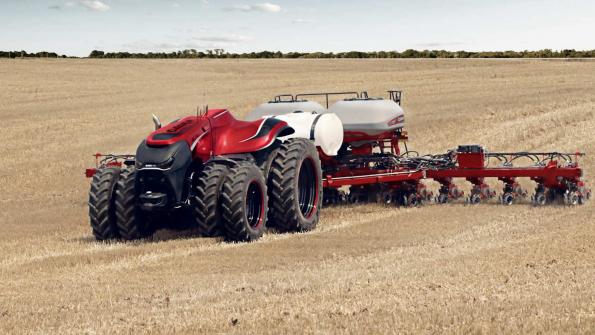November 29, 2016

The crowds around that Case IH tractor during the Farm Progress Show where it was first unveiled were big and interested. At first it was probably the novelty of a cab-less tractor sitting on a manufacturer lot, but later it may have evolved into farmers interested in how that tech could be incorporated into their operations.
Labor worries and issues continue to cloud the successful future of farms that want to get bigger but can't keep up with the crop production needs. This is one key area pushing for the development of autonomous tractors. And the statement Case IH and New Holland made at the fall farm shows, combined with the demonstration recently by Trimble, shows that this tech is closer than ever.
In fact, during the Farm Progress Show, a New Holland official noted that the tech could be live in as little as five years. For that to happen, with a commercial machine from a major manufacturer, what key factors have to fall into place? Here are four I think are important to consider for the future.
1. Operational software development
Sure a driverless tractor is pretty cool, but how do you get it to the field? That's a concern for the cab-less Case IH machine, which must make the trip to the field with no driver (yes the prototype has a small operator position, but in the final model that's not practical). The software created for these machines has to allow for some kind of transport mode - perhaps on back roads - to get from farm to field.
If a farmer has to drive that tractor to the field and turn it on to get started, just how will that farmer then return home to the farm? I'm sure many of my readers have worked through that and have some ideas, but could software allow you to "drive" the tractor to the field from your office, get it started, while you return to your spreadsheets and accounting software to find efficiencies there?
The rise of virtual reality and augmented reality gear might allow you to "drive" the tractor from your office to the field, then get it started on its way. Yes, there are technologies that could come into play here that aren't yet being used.
2. Redundant systems that should be, well, redundant
Lidar, Radar, light sensors, and other motion capturing devices are critical for these machines. The machine needs to be able to "see" where it is going so that it can slow or stop for obstacles that appear. There also need to be sensor systems to it can "see" the terrain so it doesn't accidentally find itself in a bad place - like a hole.
Of course, the primary safety system has to be something to keep the driverless machine from hitting someone who accidentally walks in front of the machine. And those systems have to be reliable even when there's a lot of dust and dirt - which tends to happen on a hot April day when you're in the midst of the busy planting season. Dust can't hinder the sight of the machine, it must still - for safety's sake - be able to see what's ahead so on one gets hurt.
And a corollary to this point is the potential regulatory environment for these machines. While entrepreneurs are hard at work on these kinds of systems - like ATC and others - how will regulators weigh in on the idea? That too will need to be worked out before these machines become commercially available.
3. The tending solution must be worked out
Running a planter at 2 in the morning with a driverless tractor while you stay nestled all snug in your bed sounds delightful. Until the planter runs out of seed at 3:44 a.m. and the tractor calls for a "tending." In fact, if the system is really on the ball, it would be designed to call you and offer this message: "Your planter will run out of seed in one hour, please respond and travel to this location (GPS coordinates) to tend to the machine so this operational unit does not have to stop for long."
An early warning when tending is necessary is great. But how about an autonomous tender too that just sits in wait to fill the machine planter is empty. This could simply be a robot tender that is delivered to the field the same time the tractor is with enough seed to get the machine through 12 to 16 hours of work.
It's the logistics of these systems that will need to be worked out too.
4. The consumer must accept the concept
Social media can be quite enlightening. The announcement of the new autonomous machines at farm shows drew praise, interest and fascination. They also drew negative comments from farmers who complained that an autonomous machine "takes away the most fun part of farming."
For the farmer-son owner-operator farm perhaps the autonomous tractor is a tougher decision. For larger operations where machinery is run by hired labor, cab-less/operator-less machines may have more appeal. Labor reliability and availability has been responsible for a range of machinery innovations for years. It will be a driver here too in several markets.
In a conversation I had with a Tennessee farmer earlier this year, there was interest in autonomous machines that could "follow along" with a conventional machine in the field. Picture a cab-less combine following behind its conventional brother during harvest. Of course tending that system would be your biggest challenge. Yet if you could double harvest capacity with less labor and without putting a giant combine in the field, would that be worthwhile.
It's technology developments like this that make American agriculture so interesting to cover. It may be awhile before we see robot tractors covering the countryside, but interest remains high.
You May Also Like




